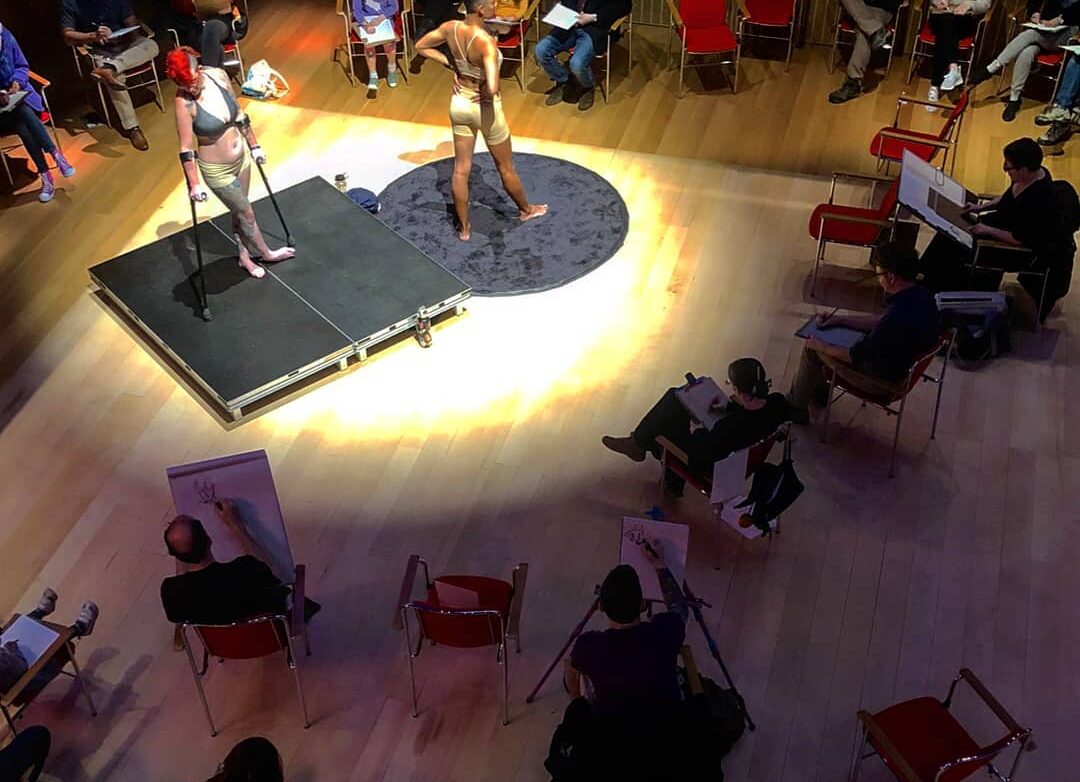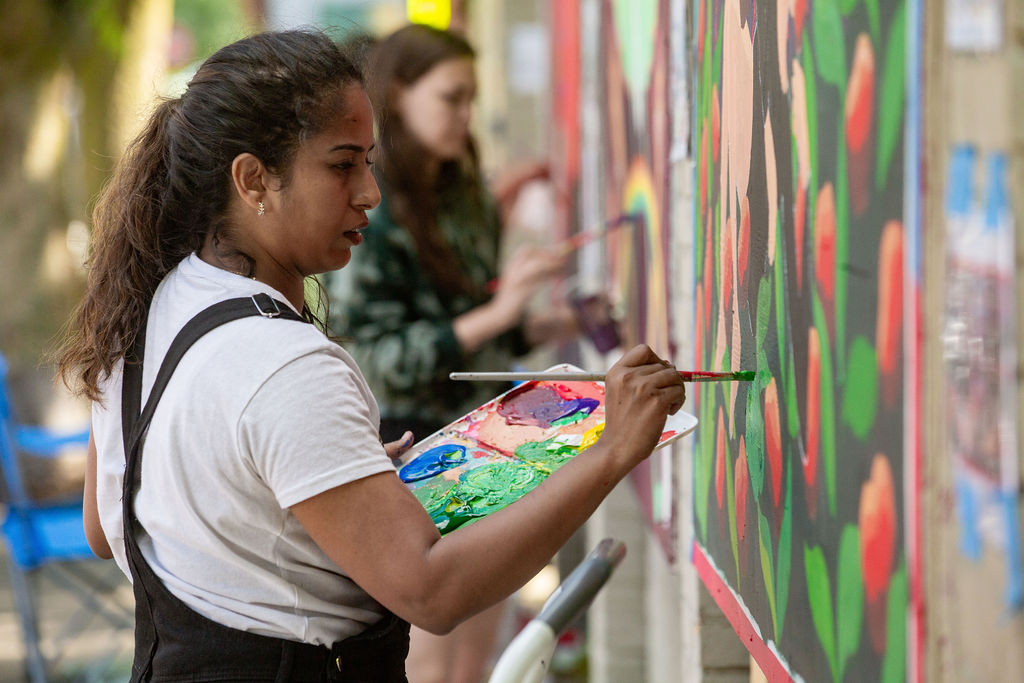
by Joey Phoenix*
Images provided by Figure On Diversity
On April 3rd, Figure On Diversity will be partnering with London-based 2B or Not 2B Collective for their Online Figure Modeling Workshop. The purpose of the workshop is to “provide a safe entry into nude figure modeling for those who may not have previously considered the practice accessible to them,” including People of Color, and people who are Fat, Trans, Non-Binary, or Disabled or some intersectional combination thereof.
Recently, Figure On Diversity joined up with a UK-based figure drawing organization, Fat Life Drawing, for FOLD, an Online Figure Drawing event featuring three diverse models from Georgia, Massachusetts, and Ohio. In the three hour Zoom session, the figure models posed for more than 165 accounts ranging across international borders from San Franciscoto Berlin.
The most remarkable thing about this event wasn’t that the models were posing in different states or that well over a hundred people attended the event (very uncommon for life drawing classes), but that the models’ intersectional identities included Queer, BIPOC, Disabled, Trans and Fat, which are not often seen in arts education or life drawing circles.
*Editor’s Note: As I am a white, non-binary, femme figure model with an invisible illness, I do not have the requisite editorial distance to be fully objective about this piece. I have done the best I can.
Arts Education without figure models? Not a Chance.
The world of Fine Art™1 and arts education could not exist without figure models, yet they remain largely set apart from the rest of the art world. Models pose – sometimes nude, sometimes clothed – on a table, dais, or floor (less common) so that art students, amateurs, and professional artists can directly study and create art inspired by their figure.
Figure models go to great lengths to never break a pose, holding themselves perfectly still for incredible lengths of time (sometimes up to an hour), and, despite all of their efforts, have very few advocates in the industry. There is also a recognizable problem with representation as many of the models in Greater Boston are (or pass as2) white, cisgender, fem/femme, thin, athletic, and able bodied despite the population being far more diverse in every way.
Seeing these challenges pop up again and again during their time both in art school and while modeling, Angela DeCarlis (they/them/theirs), created Figure On Diversity, an organization which aims to increase diversity among figure models in arts communities through arts education and workshops geared towards those looking to try figure modeling for the first time.

Also in direct response to this challenge, DeCarlis hopes to release their three-book figure modeling primer, Modeling Modeling, which will be a guide for figure models, instructors and moderators, and art administrators aimed to standardize and make equitable the practices of modeling, working with models, and hiring models.
1The trademark is a joke. As a self-taught contemporary visual artist and figure model, I have observed Fine Arts and Accessibility to be mostly mutually exclusive up until recently. If you have questions or comments about what this means, I highly encourage you to message me so we can talk about it.
2The Boston figure modeling scene has a predominant queer and trans subsection, of which I am a part. When we are asked if we would like to be listed as “male” or “female” on the model roster, it gives us feelings. Also, many of us – also me – have invisible illnesses and hidden disabilities, so although we may pass as able-bodied and athletic, we might have trouble holding a standing pose for 20 minutes or more.
Modeling Modeling – Coming Out in Fall 2021
A portrait painter, figure drawing instructor, and former figure model, DeCarlis studied at the Pennsylvania Academy of Fine Arts before moving to Boston to finish their degree in Studio Arts from Lesley University. From there they became involved as an advocate and community organizer for the Figure Models of New England Facebook Group, along with Izébel Vivant (she/her/hers) and Gina Terzino (she/her/hers), before eventually founding Figure On Diversity. They are currently an MFA candidate at the University of Florida.
While a small number of resources do exist for figure models and those they work with, most of them center on able-bodied models who are also cisgender, white, athletic, and thin. This has led to a bit of a chicken and egg problem in the art world because if the resources don’t exist for certain bodies, it signals that those bodies aren’t welcome, even if they are.
“It’s more of a perceived barrier to entry rather than an authentic one because anyone can walk in off the street and be a figure model. If they show up on time and they do the work, they are suddenly part of the art ecosystem and are officially involved in the conversation,” said DeCarlis, admitting that while this is true, the homogenized nature of art programs coupled with ambiguous signalling about who can be a model is problematic.
DeCarlis is releasing Modeling Modeling to try to raise awareness around this issue and to guide people towards a more equitable and standardized method for figure modeling and for hiring figure modeling. It will be a three-part series, with the first guidebook being geared towards models, the second for instructors and workshop organizers, and the third for administrators – the people who hire models.
Another of the challenges in the industry, In addition to the diversity piece, that DeCarlis and Figure On Diversity hope to address is the ways in which the profession blocks access to models who are disabled or need special accommodations for access.
“Many of the people who work with and hire models are operating under the assumption that the models are going to be able to get up onto a model stand and pose safely in that space for at least 20 minutes without breaking the pose,” DeCarlis said, adding that for many non-able-bodied people these restrictions are prohibitive.
It’s also astounding to them that the taboo of “don’t break the pose” is still so prevalent in arts education even today.
“It’s amazing reading interviews and hearing what models would rather do than break the pose. Things like, ‘Oh, I’d rather be bleeding menstrually than break the pose,’ or ‘I’d rather be standing there maintaining an accidental erection than break the pose.’ It’s just so unbelievable to me.
“The unprofessionalism associated with breaking poses even under extreme circumstances prevents models – especially those with disabilities – from protecting or taking care of their bodies.”
Who can be a figure model? Anyone with a body.
While some people – whether for religious reasons, body or gender dysphoria, or lack of interest – don’t want to be figure models, there are many others who would want to do the work who don’t know that they can. For those who don’t fit into the white, cisgender, fem/femme mold, it’s hard to feel empowered to do this work to begin with, which has led to the homogenous nature of the Boston modeling scene.
It’s not that different kinds of bodies can’t model, it’s just that when those bodies aren’t being seen or intentionally sought after, it’s hard to believe that it’s even an option.
One problem, DeCarlis explains, isn’t that white, femme/fem, thin, and abled bodies are the only ones sought out, but that those whose bodies don’t fit into that very small category often self-deselect themselves for these roles.
“Most artists want to be capturing a diverse range of models but may not necessarily have control over who they are making art of beyond who is available and advertising themselves as a figure model,” DeCarlis explained. “Part of my motivation for starting in on Figure On Diversity was to check into why this was happening and why this diversity piece was missing.”
For those outside of the Figure Modeling world, and to some degree those inside, there are many stereotypical misconceptions about the kind of body needed to be a figure model. It doesn’t help that throughout history beauty standards of thin, elegant, and lithe bodies have been set in literal white marble.
“This stereotype mainly exists because of Greco-Roman statuary and thousands of years of art history. It’s so baked into our culture that even people who have nothing to do with art will use the phrase ‘to put on a pedestal’ to describe giving special treatment to an ideal thing or person,” DeCarlis explained.
Figure On Diversity has chosen to take this stereotype head on, working to empower individuals of all body types and identities to enter the profession and to advocate for them in professional and academic settings through workshops, new publications, and through a new collaborative initiative called BustEd.
Representation in the Future of Arts Education
For many artists and art educators, having a figure model booked for a session is ideal, but when that just isn’t possible they tend to work from still life or plaster busts. Learning the figure from plaster busts is also an intermediary step for many artists to help them progress from working with still life to studying the figure.
Unfortunately, the materials available to art students and instructors tend to be exclusively white, idealized, and predominantly male.
This recognition led to the creation of BustEd, a new initiative between Figure On Diversity and sculptor Morgan Yacoe with the purpose of creating new diverse sculptural references for use in the classroom.
“We found out through research that there are only about three plaster casts available for purchase of models of color, one of which is called ‘Why Born Enslaved,”’ and is explicitly a portrait of an enslaved woman – there’s rope binding the edge of the bust,” DeCarlis explained.

“‘Why Born Enslaved’ was sculpted in France in the 1800s in support of abolition, which makes sense for the time, but in the context of the classroom, drawing an enslaved person is a violence against students of color. We need some updates,” they added.
Figure On Diversity is working to ensure that the future of arts education is representational in ways that it hasn’t been before. These values have already been supported in the San Francisco Bay and Philadelphia arts scene prior to the existence of organizations like 2B or Not 2B Collective, Fat Life Drawing, and Figure On Diversity, but DeCarlis and those like them are working to help them catch on everywhere else as well. And while a diversity of figure models may not be possible in smaller art communities, BustEd will be able to help fill in those gaps.
“The BustEd program is one way of incorporating diversity in the curriculum for places where diversity isn’t just going to happen. It’s also a way of increasing accessibility to representation for folks who wouldn’t be comfortable posing nude – often due to dysphoria, religious, or cultural reasons,” they added.
You can find out more about Figure on Diversity’s ongoing work on their new website https://www.figureondiversity.com/ or by following them on Instagram. They are also looking for participants for their upcoming April 3rd workshop, which you can apply to here.

This month, Creative Collective is celebrating Women’s History Month! Follow along as we tell the stories of women small business owners and woman-led organizations.
And make sure to use the hashtags #shareHERstory, #shareTHEIRstory*, or #shareyourstory to highlight the women, the femmes/fems, and the non-binary/genderqueer individuals in your community who have and are continuing to inspire you.








